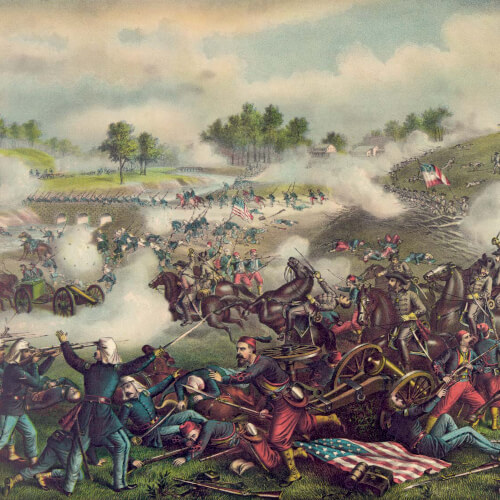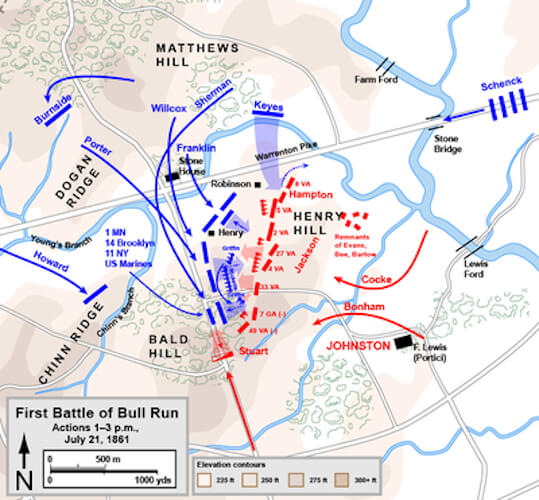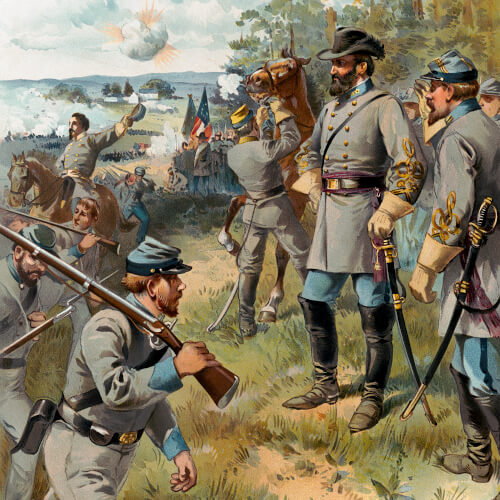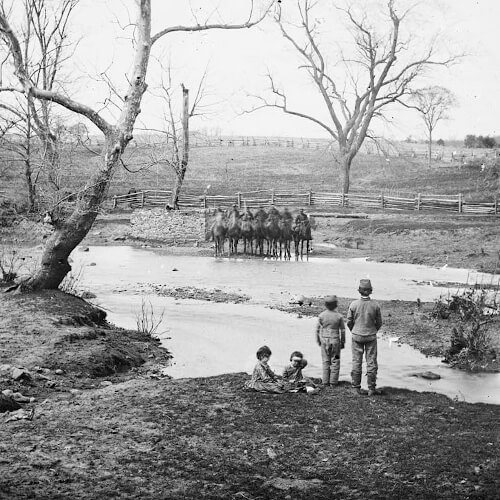Civil War Battles and Engagements
Exploring various battles and skirmishes of the Civil WarThe First Battle of Bull Run
The First Battle of Bull Run, also known as the First Battle of Manassas, was fought on July 21, 1861 and was the first major battle of the Civil War. Approximately 36,000 inexperienced troops clashed about 25 miles southwest of Washington DC it what would end up being a Confederate victory.
A Gathering Storm
Shortly after the events of Fort Sumter, people in the North began calling to put down the rebellion by attacking the Confederate Capital in Richmond Virginia. On April 15, 1861, President Abraham Lincoln issued a proclamation declaring an insurrection while South Carolina and other southern states seceded from the Union. To aid in putting down the rebellion, Lincoln called for 75,000 men to volunteer for 90 days. As the inexperienced men arrived and gathered in Washington DC, they brought with them a host of other problems including their families, disease, and hopes of a quick end to the conflict. Passions quickly ran high as more and more troops arrived and by July the Union troops and newspapers were shouting “On to Richmond.”
By July, Union and Confederate armies were beginning to gather in Virginia. On the Union side, General Irvin McDowell’s army was defending Washington DC while General Robert Patterson’s forces were about 60 miles away. On the Confederate side in Virginia, Generals Joseph E. Johnston and P.G.T. Beauregard were near Manassas, Virginia.
On to Richmond!
On July 16, 1861, people lined the streets of Washington DC to watch at General Irvin McDowell’s 35,000 raw troops marched out of town and “On To Richmond.” Meanwhile, Confederate Brigadier General P.G.T. Beauregard had nearly 22,000 troops protecting the rail station at Manassas Junction. On July 18, Union forces under Brigadier General Daniel Tyler fought a skirmish with Confederate troops at Blackburn’s Ford along Bull Run. McDowell’s plan was to divide his troops and attack both flanks of the Confederates while General Patterson’s troops would attack Confederate General Joseph Johnston which would prevent reinforcements from arriving to help Beauregard.
On the morning of July 21, McDowell launched his attack by sending troops north towards Sudley Springs Ford and around the Confederate left. At 5:30am, the shot of a 30-pound Parrott rifle broke the silence and started the first battle of the Civil War. As the battle began, Union troops crossed Bull Run and attacked the Confederate left. It appeared as though the Union forces would win the day was 10,000 troops pushed 4,500 rebel troops back across the Washington Turnpike.
“Stonewall” Jackson
As reinforcements arrived for both sides, there was a standstill in the battle. The battle eventually moved toward the Warrenton Turnpike and Henry House Hill where there were numerous attacks and counter-attacks. The battle moved toward Henry House Hill (near the Warrenton Turnpike), where the two forces pushed each other back and forth for a while. As Confederate reinforcements arrived by railroad from the Shenandoah Valley, on Virginia brigade made a stand that would change the battle.
This brigade was led by Brigadier General Thomas Jonathan Jackson, a former teacher at the Virginia Military Institute. As the Union forces attacked, Confederate Brigadier General Barnard Bee from South Carolina shouted, “There stands Jackson like a stone wall. Rally on the Virginians.” The Virginians stood their ground and the Confederates launched a counterattack and the battle turned into a rout as Union troops scattered and fled back toward the safety of Washington DC.
Aftermath
In the end, McDowell’s army suffered 460 killed, 1,1124 wounded and over 1,300 missing while Beauregard had 387 killed, 1,582 wounded, and only 13 missing. Overall, the battle was fought by mostly undertrained officers and of the nearly 60,000 men on the field that day, only about 18,000 actually fought.
The battle also had an impact on the overall view of the war. Northerners, including President Lincoln, were hoping to achieve a swift and decisive victory in order to bring a quick end to the rebellion. With their victory, Southerners were elated and confident in their ability to defeat the Yankees. In the end, both sides realized that they were in for a long and grueling war and that the first Battle at Bull Run was just the beginning.
Ammunition
P.G.T. Beauregard
Pierre Gustave Toutant Beauregard was a Confederate general during the Civil War. Born in May 1818 in Louisiana and later attended West Point, however in February 1861, Beauregard resigned from the U.S. Army and ordered was responsible for the first shots of the CivilWar when he ordered the bombardment of Fort Sumter in April 1861. It was Beauregard who was a key in the Confederate victory at First Bull Run and he also participated in the Battles of Shilo and Corinth. Unfortunately, due to his unfriendly relationship with Confederate President Jefferson Davis, Beauregard was transferred and placed in command of the defenses around Charleston, South Carolina. While there, he repeatedly held off numerous Naval attacks by US ships and in 1864 he led the defense of Petersburg. After the war, Beauregard worked as a railroad director and as a supervisor for the Louisiana Lottery. He died in 1893 at the age of 74.
Irvin McDowell
Irvin McDowell was born in October 1818 in Columbus, Ohio, and would grow up to graduate from West Point. As a US Army officer, he served during the Mexican War, and in 1861 he was promoted to brigadier general. He was given the command of the Department of Northeastern Virginia. When the Civil War broke out, he was defeated at the First Battle of Bull Run however due to his loss, he was relieved of his position. In 1862, he returned to Bull Run and fought as a major general and a corps commander. Again, he was relieved of his command due to his conduct during the battle. For the next several years, he was given various commands and assignments until he retired from the U.S. Army in 1882 and died of a heart attack in 1885.
Stonewall Jackson
Thomas “Stonewall” Jackson was born January 21, 1824, in Clarksburg, Virginia. In 1846, he graduated from the US Military Academy and quickly earned two promotions while serving in the Mexican War. After his service in Mexico, he became a professor at the Virginia Military Academy where he earned the nickname “Old Blue Light.” When Virginia seceded from the Union, Jackson joined his home state in the Confederate army. Later that year, Jackson earned the respect and admiration from his troops and other commanders through his fearlessness and determination in the early part of the war. Jackson was a key figure in many battles until his mortal wounding by friendly fire during the Battle of Chancellorsville in May 1863. He was 39 years old.
Joseph E. Johnston
Joseph E. Johnston was a graduate of the United States Military Academy and a veteran of the Mexican war and when he resigned his commission and joined the Confederacy, he was given the rank of general. He was instrumental in the victory at First Bull Run but later would come under fire for retreating during some of the fighting during the Peninsula Campaign in 1862. During the Battle of Seven Pines in June 1862, Johnston was severely wounded and was replaced by Robert E. Lee. Johnston would later command troops in the Western Theater until surrendering to General William T. Sherman in North Carolina in April 1865. After the war, he worked as a railroad executive and insurance agent. He also served a term in the U.S. Congress. He died in 1891 at the age of 84.
Learn More
Videos
Vocabulary
Abolitionist: a reformer who favors putting an end to slavery
Confederacy:, The government formed by the states in the South after they withdrew from the United States
flee: to run away quickly
ford: a shallow place in a river or stream allowing one to walk or drive across.
Rebel: was applied as a nickname for Confederate soldiers by the Federal soldiers in the American Civil War; `greyback’ derived from their grey Confederate uniforms
Reconstruction: A term used to describe the time in American history directly after the Civil War




